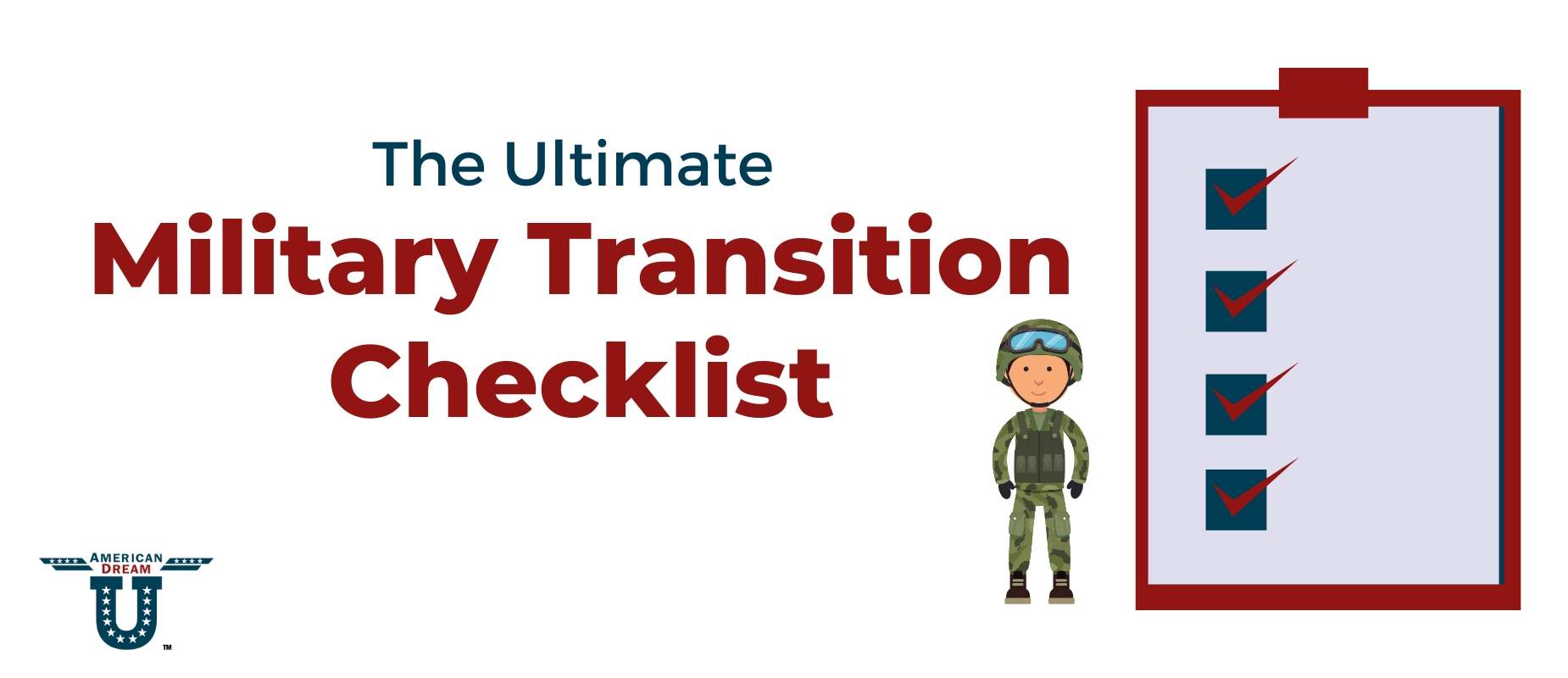The Ultimate Military Transition Checklist
Military Retirement Checklist Will Be The Same If You’re Looking To Work After Getting Out
The day you have been waiting for is approaching fast. There is a mix of feelings, excitement for what is to come…and yet fear for what is to come.
Terminal leave is almost over, you are faced with the prospect of not having an income after that last LES is produced and that last paycheck is deposited.
Whether you are getting out of the military after 4 years or 20, all soldiers, airmen, sailors and marines take that uniform off for the last time at some point.
Whether you are the service member or your spouse is, think about this, is your family ready for this transition?
No matter if your family is at the point of retiring or separating and moving on to other career ventures, there is a basic checklist that should be completed before you even take that uniform off.
If you thought that a normal PCS was stressful, wait until retirement.
This extensive process has so many things to think about both military wise and personally that it can get overwhelming quickly. However, by following a checklist, you can break down the tasks that need to be completed into more manageable items and start to tackle it the only way that a military family knows how, by putting one boot in front of the other.
There are many facets of this transition and no one is going to care more about your separation or retirement then you will so make sure that you understand the process, any benefits you should take advantage of and what is entitled to you before you get to the point of needing it.
Here is a checklist to help make the process less stressful. It is broken down by the amount of time away from a retirement or separation to help make it a little easier to follow and help tasks not sneak up on you.
Make sure to check your ETS (Expiration of Term of Service) date before making plans around it. Your military pay stub should have the date on it and once you know when you want to get out, the countdown officially begins.
18 Months from Separation: The Talk Phase
1. Have a family meeting
Although you may think that you have forever until you are getting out, the last 18 months will be faster than you think. There are many items that you don’t want to leave until the last minute, so make sure to take a long-term approach to your countdown. Complete things as far out as you can to set you and your family up for success.
The first thing that you should do, if you haven’t at this point, is to sit down with your family and decide what is going to happen when you get out.
There are many factors that can play into this.
Does your spouse work? Do you want to move? Do you want to work in a similar field, a different one or retire all together? Do you have children in school?
Have a real and frank conversation between you and your spouse with what the goals and expectations are for the future. Some spouses have put their career on hold for 5, 10, 15 years and may want the chance to take a front seat, while others may have a desire to move to a certain location.
Get on the same page as a family, and by family I mean, don’t leave out the children. While they may not have decision making power, older children especially could contribute to the idea of the next chapter.
2. Inform Your Chain of Command
If you are the service member, make an appointment with your current supervisor. They may not know your wishes and can more than likely offer helpful advice and support.
Need to attend events, workshops or just need to take leave to get your affairs in order? Making sure your supervisor is supportive and onboard can help de-stress this process immensely.
This will also give them time to train other people for your position or to request a backfill if you are retiring before the allotted time on station that your personnel center was tracking for your billet.
15 Months from Separation: The Search Phase
1. Begin the Career Search
Now that you know what you and your family’s needs are going to be after military retirement or separation, you can start searching for the things you will need in order to be successful after the transition.
For most people, this will be a job.
Start to look into resources to develop your resume.
You can also comb through your computer folders and your email files to make sure that you don’t forget to add any accomplishments to your new resume. Even if you don’t have a resume developed yet, write down quick bullet points to remind you about various parts of your position.
Many military personnel need help with this step, so don’t be afraid to ask. You aren’t asked to make a resume to submit with your dream sheet, so it isn’t a skill that most soldiers have developed.
That is okay.
There are many free resources that help review military resumes. It is also becoming more common to have resume reviews at job fairs, so take advantage of these types of services.
On the other hand, if you are looking to start your own business, look ahead and the types of training that you will need to get it off the ground. Enroll in workshops or seminars that can help you make your dream a reality.
2. Get Smart on Requirements for New Aspirations
If you are planning to start your own business or you are planning on changing careers from what you did in the military, you may need more schooling or a certain degree for your new desired profession. Start to understand the requirements and process now.
If you want to use a GI Bill or apply for other types of aid, make sure that you don’t leave that until the last minute or there may be a gap between your military separation and when you are qualified in your new role.
Many schools allow you to apply in advance and set a start date in the future.
While still in, some military members can qualify to take CLEP exams and essentially quiz out of certain general college classes. This could help speed up the process and allow you to qualify for a new career quickly.
There are also programs like Onward to Opportunity that will allow you to retain a new skill set and certifications for free within 6 months of separating.
These new skills could help you become an entrepreneur right out of the gates.
12 Months from Separation: The Forms Phase
1. DD2648
One year to go, and the real work begins.
Start this phase with the DD2648. This is going to be your holy grail through the rest of the process. It is referred to as the Pre-Separation Checklist.
This is the official list and will provide the service related things that you need to complete. There is even a column for your spouse on some of the items. The DD2648 will highlight many great resources for veterans and you can opt to receive more information about the programs listed if they apply to you.
The DD2648 should be prepared for you well before you have 89 days left on active duty. There is even an area on there to indicate if you did not receive it with more than 89 days remaining.
Since some of the items take some research to answer, I would recommend getting it as early as possible.
2. VMET
Make sure that you look at your VMET (Verification of Military Experience and Training) and make sure that everything is correct on it.
Often times there are mistakes and these mistakes can take weeks maybe even months to get sorted out. Once you out-process the military, you won’t have access to your records as easily anymore, so get this fixed now.
If you are hitting roadblocks with this step, alert your supervisor right away.
10 Months from Separation: The Arrange Phase
1. Build Your Personal Network
Make sure to join social media platforms like LinkedIn and build up your network. Find the people that you know and start to connect with them.
You should have your resume developed at this point, so enter your skills and qualifications to your profile page and see if you can connect with individuals that are in the career field you are looking to break into.
7 Months from Separation: The Research Phase
1. HHG Counseling
Make sure to contact your TMO office at this time and schedule a counseling session. They should be able to explain what will happen one you are ready to move and give you a timeline of when this would be occurring.
Even if you have PCS’d 15 times in the last 20 years, this move will be a little different then the ones that you are used to and may have different rules that you need to be aware of.
Don’t be the victim of someone else’s failure.
That means don’t only rely on TMO to tell you each and every rule, since if you have been in for a number of years, you probably already know that some TMO offices are better than others.
Look up the information yourself or ask a supervisor about what you are being told to verify you are going to receive the services you are entitled to on this last move.
Just like when you were moving to another duty station, take into account the time of year that you are separating. Is it during the peak summer PCS time?
If so, you may want to make sure you schedule a good set company of movers before the rest of the base received their orders and runs to TMO.
If you live in base housing, make sure that you understand the move out rules and if there is a timeline for when you need to be out of the house based on your separation date.
Doing all this work in advance will allow you to actually enjoy those last few months instead of being stressed out because there aren’t movers available to schedule for your chosen move out day.
2. Research Healthcare Options
If you don’t have employment lined up at this point, you may need to look into civilian health care options.
If you are retiring, however, get smart on how to still use Tricare for you and your family. Just like your USAA eligibility, if you are retiring some benefits will carry over into retirement with you.
Even when you get into the civilian world or have employment set up already, there may be a gap in coverage. Do the research and know what type of plan you and your family will need until you find that next job.
No matter which type of way you are exiting the military, it is important to think about these steps and budget out what it will cost your family if they need care.
3. Schedule a Military Separation Physical
It is a good idea to make sure and get an appointment with all of the doctors that your family usually sees. In addition, it would be a good time to schedule the dentist as well for an appointment closer to the date of your separation.
Do you have prescriptions that need to be refilled? Or do you need an eye exam to make sure that you will have enough contacts to last you a few most past separation?
It is recommended that you just schedule the appointments as this time. You can make the appointments for the last month or two before your last day on active duty.
Checking all these items this will ensure that everyone is current with all their prescriptions and will allow you to pick the days and times that are most convenient for you. It can also buy you time to find a job and make the switch to Employer Provided Health Care.
5 Months from Separation: The Get Serious Phase
1. Apply for Jobs & Attend Job Fairs
If your plan is to move into another career when you get out, you should be hitting the networking hard at this point. Attend career fairs, join social media groups.
There are groups and companies that specialize in helping veterans get employment after separation like Hiring Our Heroes for the military member or VirtForce for spouses.
You can also sign up to attend workshops or meetups to help network like the ones that American Dream U hosts. You never know which one of these events will help you land a job, so step up and try them all.
2. Research GI Bill benefits
Make sure to do the research on your GI Bill benefits. There are different types of plans that service members are on and you need to make sure you are well versed in the rules of yours.
If you would like to transfer your Post-9/11 benefits to your dependents, do research on if you need to do that before you get out.
On the other hand, if you are planning on using them yourself, think about if you want to start a program right away and see if you can apply for it in advance. The paperwork for the GI Bill takes some time to get approved, so plan this in advance to take full advantage.
3. Schedule a Meeting with Legal
Now that you won’t be deploying anymore and changing where you live, this would be a great time to make sure that the family wills are up to date. Legal can also help with other financial documents, like Power of Attorneys for any part of the moving process.
Once you get out these services will most likely not be free anymore, so take advantage now.
3 Months from Separation: The Learning Phase
1. Review of Finances
Whether you are the family financial guru or you have a financial advisor, this is the time where it is critical that you plan and budget for at least 6 months past your separation date.
Moving and setting up a new home will occur expenses and you are about to receive your last government paycheck (unless you are retiring, then it will just be a smaller paycheck).
Either way, make sure that you have a budget and are on track to stick to it through this transition.
2. Learn about Life Insurance Options
When you were active duty, you did not have a lot of choices when it came to life insurance. It isn’t something that most people like talking about but is an important conversation to have to make sure that your family will be covered in the face of a tragedy.
Look at the differences between SGLI and VGLI and also research other options to make the best decision you can.
3. Gather Medical Records for the Whole Family
Oh boy. Dealing with medical records can be a pain with the military. Set yourself up for success and request this documentation early.
Some offices make you wait a week or more to pick up the records and sometimes it takes a while to track down all of the records to make sure that you have everything.
This is a good time to do that because if you get the record too early, you could miss the records for those last appointments.
As a side note: If you are retiring with a service-related disability, you may need to provide proof to the VA to get your benefits started.
So, don’t skip this step!
Make sure you have already seen the doctor in your separation physical to document any service-related injuries.
1 Month from Separation: The ‘It Just Got Real’ Phase
1. Attend TAP (if you haven’t already)
Some bases or posts will make you attend TAP (Transition Assistance Program) before this point in your separation. However, if they haven’t, make sure to get yourself scheduled.
TAP is actually a useful workshop that can help you with this transition. You can do this through your Transition Assistance Office and each program is catered to a certain branch of service.
In fact, there are now many types of transition programs that you should try and take advantage of. Many of these you can even attend during the workday.
2. Schedule Photos
This may sound like a funny thing to do during this crunch period but trust me you will want these photos later in life.
Schedule official pictures to be taken in your various uniforms or even with your family as a memento of your time in the service. Children and even grandchildren can look on these in the future with pride.
A headshot photo can also be useful to use in your LinkedIn profile to help you find a job with a veteran-friendly employer.
3. Finish the Last of the Check-List Items
Now it is time to check the last things off your checklist and make sure that everything is squared away. You especially want to make sure you have your DD214 paperwork submitted, as well as your records, awards and certifications documented and saved in a safe place.
If you are retiring, you may even get a plaque thanking you for your service signed by a base or post commander. Ask your supervisor or Chief about this.
The Day of Separation: The Now What Phase
YOU MADE IT.
1. Breathe!
You are there. Congratulations for completing your service to this country and now take a minute and be proud of everything that you have accomplished.
You are officially starting the next phase of your journey. You earned it.











